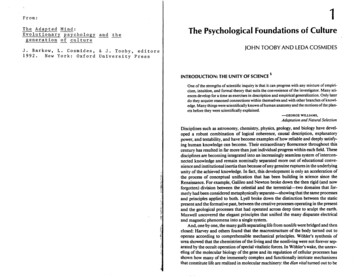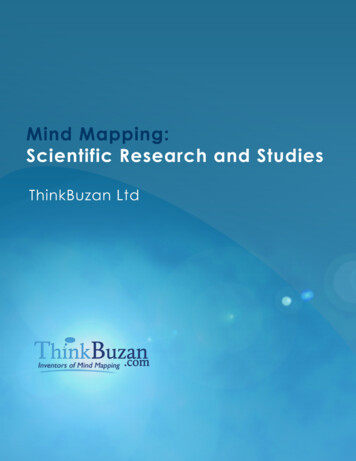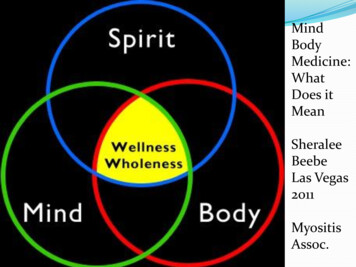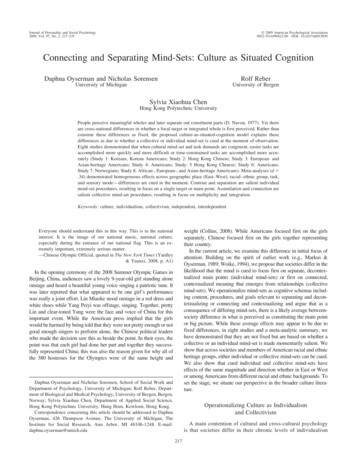
Transcription
From:The Adapted Mind:Evolutionary psychologyof c u l t u r egeneration Barkow, L. Cosmides,1992.New Y o r k : O x f o r dJ.The Psychological Foundations of CultureJOHNTOOBY AND LEDA COSMIDESINTRODUCTION: THE UNITY OF SCIENCEOne of the strengths of scientific inquiry is that it can progress with any mixture of empiricism, intuition, and formal theory that suits the convenience of the investigator. Many sciences develop for a time as exercises in description and empirical generalization.Only laterdo they acquire reasoned connectionswithin themselves and with other branches of knowledge. Many things were scientifically known of human anatomy and the motionsofthe planets before they were scientifically explained.-GEORGEWILLIAMS,Adaptation and Natural SelectionDisciplines such as astronomy, chemistry, physics, geology, and biology have developed a robust combination of logical coherence, causal description, explanatorypower, and testability, and have become examples of how reliable and deeply satisfying human knowledge can become. Their extraordinary florescence throughout thiscentury has resulted in far more than just individual progress within each field. Thesedisciplines are becoming integrated into an increasingly seamless system of interconnected knowledge and remain nominally separated more out of educational convenience and institutional inertia than because of any genuine ruptures in the underlyingunity of the achieved knowledge. In fact, this development is only an acceleration ofthe process of conceptual unification that has been building in science since theRenaissance. For example, Galileo and Newton broke down the then rigid (and nowforgotten) division between the celestial and the terrestrial-two domains that formerly had been considered metaphysicallyseparate-showing that the same processesand principles applied to both. Lye11 broke down the distinction between the staticpresent and the formative past, between the creative processes operating in the presentand the geological processes that had operated across deep time to sculpt the earth.Maxwell uncovered the elegant principles that unified the many disparate electricaland magnetic phenomena into a single system.And, one by one, the many gulfs separatinglife from nonlife were bridged and thenclosed: Harvey and others found that the macrostmcture of the body turned out tooperate according to comprehensible mechanical principles. Wohler's synthesis ofurea showed that the chemistries of the living and the nonliving were not forever s e parated by the occult operation of special vitalistic forces. In Wohler's wake, the unraveling of the molecular biology of the gene and its regulation of cellular processes hasshown how many of the immensely complex and functionally intricate mechanismsthat constitute life are realized in molecular machinery: the 6lan vital turned out to be
20EVOLUTIONARY AND PSYCHOLOGICAL FOUNDATIONSnothing other than this microscopic functional intricacy. Most critically, Darwinshowed how even the intricately articulated functional organization of living systems(then only observable at the macroscopic level) could be explained as the product ofintelligible natural causes operatingover the expanse ofdeep time. In so doing, he conceptually united the living and the nonliving into a single system of principled causation, and the entire diversity of plant, animal, and microbial species into a single treeof descent. Darwin took an equally radical step toward uniting the mental and physicalworlds, by showing how the mental world-whatever it might be Amposed of-arguably owed its complex organization to the same process of natural selection thatexplained the physical organization of living things. Psychology became united withthe biological and hence evolutionary sciences.The rise of computers and, in their wake, modem cognitive science, completed theconceptual unification of the mental and physical worlds by showing how physicalsystems can embody information and meaning. The design and construction of artificial computational systems is only a few decades old, but already such systems canparallel in a modest way cognitive processes-such as reason, memory, knowledge,skill, judgment, choice, purpose, problem-solving, foresight, and language-that hadsupposedly made mind a metaphysical realm forever separated from the physicalrealm, and humans metaphysically disconnected from the causal network that linkedtogether the rest ofthe universe. These intellectual advances transported the living, themental, and the human-three domains that had previously been disconnected fromthe body of science and mystified because of this disconnection-into the scientificallyanalyzable landscape of causation.One useful way to organize this knowledge is as a principled history of the universe.Starting with some characterizable initial condition (like the Big Bang), each successive state of the system is described, along with the principles that govern the transitions from state to state. To the extent that our scientific model is welldeveloped, weshould be able to account for the types of entitiesthat emerge (pulsars, tectonic plates,ribosomes, vision, incest avoidance) and their distribution and location in the causalmatrix. Such a history-in its broadest outlines-is well on its way to being constructed, from an initial quantum state, to the formation and distribution of particlesduring the early expansion, to the cooling and formation of atoms, the formation ofgalaxies, stellar evolution, the synthesis of heavier nuclei, and, of parochial interest tous, the local history of the solar system. This includes the formation of the sun andplanets; the geochemistry of prebiotic earth; the generation of ccmplex organic compounds; the emergence of the initial ancestral reproducing chemical system; the evolution of the genetic code and prokaryotic design; the emergence of eukaryoticsexualorganisms, multicellular plants, animals, and fungi; and the rest of the history of lifeon earth.In this vast landscape of causation, it is now possible to locate "Man's place innature" to use Huxley's famous phrase and, therefore, to understand for the first timewhat humankind is and why we have the characteristicsthat we do. From this vantagepoint, humans are self-reproducing chemical systems, multicellular heterotrophicmobile organisms (animals), appearing very late in the history of life as somewhatmodified versions of earlier primate designs. Our developmental programs, as well asthe physiological and psychological mechanisms that they reliably construct, are thenatural product of this evolutionary history. Human minds, human behavior, humanTHE PSYCHOLOGICAL FOUNDATIONS OF CULTUREartifacts, and human culture are all biological phenomena-aspects of the phenotypeiof humans and their relationships with one another.The rich complexity of each individual is produced by a cognitive architecture,embodied in a physiological system, which interacts with the social and nonsocialworld that surrounds it. Thus humans, like every other natural system, are embeddedin the contingencies of a larger principled history, and explaining any particular fact.about them requires the joint analysis of all the principles and contingenciesinvolved.To break this seamless matrix of causation-to attempt to dismember the individualinto "biological" versus "nonbiological" aspects-is to embrace and perpetuate anancient dualism endemic to the Western cultural tradition: material/spiritual, body/mind, physical/mental, naturallhuman, animal/human, biological/social, biological/cultural. This dualistic view expresses only a premodern version of biology, whoseintellectual warrant has vanished.This expansive new landscape of knowledge has not always been welcome, andmany have found it uncongenial in one respect or another. The intellectual worlds webuilt and grew attached to over the last 3,000 years were laid out before much wasknown about the nature of the living, the mental, and the human. As a result, theseintellectual worlds are, in many important respects, inconsistentwith this new unifiedscientific view and, hence, are in need of fundamental reformulation. These established intellectual traditions and long-standing habits of mind seem, to many, to bemore nourishing, more comfortable and, therefore, more valuable than the alternativeprospect of new and unfamiliar scientific knowledge. To pick a single example, theshift from a universe designed to embody a moral and spiritual order to a universe thatis undesigned and is structured only by a causal order engendered an immeasurablygreater cultural dislocation than that which occurred when Copernicus identified thesun rather than the earth as the center of the planetary orbits. Consequently, .thedemystifications that have taken place since 1859 have been painful and have precipitated considerable resistance to accepting these discoveries and their implications.With the appearance of Darwinism, the full scope of the emerging unified account was,for the first time, apparent. Therefore, much of the opposition has specifically revolvedaround evolution and its application to humans. Gladstone, for example, in a debatewith Huxley, captured in his choice of language the widely shared, visceral sense ofrevulsion caused by the claim "that natural seIection and the survival of the fittest, allin the physical order, exhibit to us the great arcanum ofcreation, the sun and the centerof life, so that mind and spirit are dethroned from their old supremacy, are no longersovereign by right, but may find somewhere by charity a place assigned them, asappendages, perhaps only as excrescences, of the material creation" (Gladstone,quoted in Gould, 1988, p. 14). The dislocations in world view stemming from thisprocess ofconceptual unification led to a growing demand for, and production of, conceptual devices and rationales to divorce the natural sciences from the human socialand inner landscape, to blunt the implications of monism and Darwinism, and torestore a comfortable distance between the human sciences and the world of naturalcausation. To many scholarly communities, conceptual unification became anenemy, and the relevance of other fields a menace to their freedom to interpret humanreality in any way they chose.Thus, despite some important exceptions, the social sciences have Iargely keptthemselves isolated from this crystalizing process of scientific integration. Although
ea22EVOLUTIONARY AND PSYCHOLOGICAL FOUNDATIONSsocial scientistsimitated many of the outward forms and practices of natural scientists(quantitative measurement, controlled observation, mathematical models, experimentation, etc.), they have tended to neglect or even reject the central principle thatvalid scientific knowledge-whether from the same or different fields-should bemutually consistent (see Cosmides, Tooby, & Barkow, this volume). It is this principlethat makes different fields relevant to each other, and part of the same larger systemof knowledge. In consequence, this insularity is not just an accident. For many scholars, it has been a conscious, deeply held, and strongly articulated position, advancedand defended since the inception of the social sciences, particularly in anthropologyand sociology. Durkheim, for example, in his Rules of the Sociological Method, arguedat length that social phenomena formed an autonomous system and could be onlyexplainedby other social phenomena ( 189511962). The founders of American anthropology, from Kroeber and Boas to Murdock and Lowie, were equally united on thispoint. For Lowie, "the principles of psychology are as incapable of accounting for thephenomena of culture as is gravitation to account for architectural styles," and "culture is a thing sui generis which can be explained only in terms of itself. . . . Omniscultura ex cultura" ( 191711966, p. 25-26; p. 66). Murdock, in his influential essay"The science of culture," summed up the conventionalview that culture is "independent of the laws of biology and psychology" ( 1932, p. 200).Remarkably, while the rest of the sciences have been weaving themselves togetherthrough accelerating discoveries of their mutual relevance, this doctrine of intellectualisolationism,which has been the reigning view in the social sciences; has only becomemore extreme with time. With passionate fidelity, reasoned connections with otherbranches of knowledge are dismissed as ignorant attempts at crude reductionism, andmany leading social scientists now openly call for abandoning the scientific enterpriseinstead. For example, CliffordGeertz advocates abandoning the ground of principledcausal analysis entirely in favor of treating social phenomena as "texts" to be interpreted just as one might interpret literature: We should "turn from trying to explainsocial phenomena by weaving them into grand textures of cause and effect to trying toexplain them by placing them into local frames of awareness" (1983, p. 6). Similarly,Edmund Leach rejects scientific explanation as the focus of anthropology: "Socialanthropology is not, and should not aim to be, a 'science' in the natural science sense.If anything it is a form of art . . .Social anthropologists should not see themselves asseekersafter objective truth . ."(Leach, 1982, p. 52). These positions have a growingfollowing, but less, one suspects, because they have provided new illumination thanbecause they offer new tools to extricate scholars from the unwelcome encroachmentsof more scientific approaches. They also free scholars from all of the arduous tasksinherent in the attempt to produce scientificallyvalid knowledge: to make it consistentwith other knowledge and to subject it to critical rejection on the basis of empiricaldisproof, logical inconsistency, and incoherence. In any case, even advocates of suchavenues of retreat do not appear to be fully seriousabout them because few are actuallywilling to accept what is necessarily entailed by such a stance: Those who jettison theepistemologicalstandardsof science are no longer in a position to use their intellectualproduct to make any claims about what is true of the world or to dispute the others'claims about what is true.Not only have the social sciences been unusual in their self-conscious stance ofintellectual autarky but, significantly, they have also been relatively unsuccessful as.THE PSYCHOLOGICALFOUNDATIONS OF CULTUREsciences. Although they were founded in the 18th and 19th centuries amid everyexpectation that they would soon produce intellectual discoveries, grand "laws," andvalidated theories to rival those of the rest of science, such success has remained elusive. The recent wave of antiscientificsentiment spreading through the social sciencesdraws much of its appeal from this endemic failure. This disconnection from the restof science has left a hole in the fabric of our organized knowledge of the world where .the human sciences should be. After more than a century, the social sciences are stilladrift, with an enormous mass of halfdigested observations, a not inconsiderablebodyof empirical generalizations, and a contradictory stew of ungrounded, middle-leveltheories expressed in a babel of incommensurate technical lexicons. This is accompanied by a growing malaise, so that the single largest trend is toward rejecting thescientific enterprise as it applies to humans.We suggest that this lack of progress, this "failure to thrive," has been caused bythe failure of the social sciences to explore or accept their logical connections to therest of the body of science-that is, to causally locate their objects of study inside thelarger network of scientific knowledge. Instead of the scientific enterprise, what shouldbe jettisoned is what we will call the Standard Social Science Model (SSSM): The consensus view of the nature of social and cultural phenomena that has served for a century as the intellectual framework for the organization of psychology and the socialsciences and the intellectualjustification for their claims of autonomy from the rest ofscience. Progress has been severely limited because the Standard Social ScienceModelmischaracterizes important avenues of causation, induces researchers to study complexly chaotic and unordered phenomena, and misdirects study away f r o a r e a swhere rich principled phenomena are to be found. In place of the Standard Social Science Model, there is emerging a new framework that we will call the Integrated qausalModel. This alternative framework makes progress possible by accepting and exploiting the natural connections that exist among all the branches of science, using themto construct careful analyses of the causal interplay among all the factors that bear ona phenomenon. In this alternative framework, nothing is autonomous and all the components of the model must mesh.In this chapter, we argue the following points:1. There is a set of assumptions and inferences about humans, their minds, andtheir collective interaction-the Standard Social Science Model-that has provided the conceptual foundations of the social sciences for nearly a centuryand has served as the intellectual warrant for the isolationism of the socialsciences.2. Although certain assumptions of this model are true, it suffers from a series ofmajor defects that make it a profoundly misleading framework. These defectshave been responsible for the chronic difficulties encountered by the social sciences.3. Advances in recent decades in a number of different disciplines, including evolutionary biology, cognitive science, behavioral ecology, psychology, huntergatherer studies, social anthropology, biological anthropology, primatology,and neurobiology have made clear for the first time the nature of the phenomena studied by social scientistsand the connections of those phenomena to theprinciples and findings in the rest of science. This allows a new model to be.5d
24EVOLUTIONARY AND PSYCHOLOGICALFOUNDATIONSconstructed-the IntegratedCausal Model-to replace the Standard Social Science Model.4. Briefly,the ICM connects the social sciencesto the rest of science by recognizingthat:a. the human mind consists of a set of evolved information-processing mechanisms instantiated in the human nervous system;b. these mechanisms, and the developmental programs that produce them, areadaptations, produced by natural selection over evolutionary time in ancestral environments;c. many of these mechanisms are functionally specialized to produce behaviorthat solves particular adaptive problems, such as mate selection, languageacquisition, family relations, and cooperation;d. to be functionally specialized, many of these mechanisms must be richlystructured in a content-specific way;e. content-specific information-processing mechanisms generate some of theparticular content of human culture, including certain behaviors, artifacts,and linguistically transmitted representations;f. the cultural content generated by these and other mechanisms is then present to be adopted or modified by psychological mechanisms situated inother members of the population;g. this sets up epidemiological and historical population-level processes; andh. these processes are located in particular ecological, economic, demographic,and intergroup social contexts or environments.On this view, culture is the manufactured product of evolved psychological mechanisms situated in individualsliving in groups. Culture and human social behavior iscomplexly variable, but not because the human mind is a social product, a blank slate,or an externally programmed general-purpose computer, lacking a richly definedevolved structure. Instead, human culture and social behavior is richly variablebecause it is generated by an incredibly intricate,contingentset of functional programsthat use and process information from the world, including information that is provided both intentionally and unintentionally by other human beings.THE STANDARD SOCIAL SCIENCE MODELThe Central Logic of the Standard Social Science ModelBut one would be strangely mistaken about our thought if, from the foregoing, he drew theconclusion that sociology, according to us, must, or even can, make an abstraction of manand his faculties. It is clear, on the contrary,that the general characteristics of human natureparticipate in the work of elaboration from which social life results. But they are not thecause of it, nor do they give it its special form; they only make it possible. Collective representations, emotions, and tendenciesare caused not by certain states of the consciousnessesof individuals but by the conditions in which the social group, in its totality, is placed. Suchactions can, of course materializeonly if the individual natures are not resistant to them; butthese individual natures are merely the indeterminatematerial that the social factor moldsTHE PSYCHOLOGICAL FOUNDATIONS OF CULTUREand transforms. heir contributionconsists exclusively in verygeneral attitudes, in vague andconsequentlyplasticpredispositionswhich, by themselves, if other agents did not intervene,could not take on the definite and complex forms which characterize social phenomena.-DURKHEIM,189511962,pp. 105- 106, emphasis added.Humans everywhere show striking patterns of local within-group similarity in theirbehavior and thought, accompanied by profound intergroup differences. The Standard Social Science Model (SSSM or Standard Model) draws its enduring persuasivepower by starting with these and a few other facts, rooted in direct experience and common knowledge. It then focuses on one salient causal and temporal sequence: howindividuals change over their development from "unformed" infants into complexlycompetent adult members of their local social group, and how they do so in responseto their local human environment. The central precepts of the SSSM are direct andseemingly inescapable conclusions drawn from these facts (D. E. Brown, 199l), andthe same reasoning appears in author after author, from perhaps its most famous earlyexpression in Durkheim (1895/1962), to its fully conventional modem adherents(with updated conceptual ornamentation) such as Geertz ( 1973).The considerations that motivate the Standard Social Science Model are as follows:Step 1. The existence of rapid historical change and the multitude of spontaneoushuman "cross-fostering experiments" effectively disposes of the racialist notion thathuman intergroup.behavioral differences of any significance are attributable to geneticdifferences between groups. Infants everywhere are born the same and have the samedevelopmental potential, evolved psychology, or biological endowment-a principletraditionally known as the psychic unity of humankind. The subsequent growth ofknowledge over this century in genetics and human development has given strongempirical support to the conclusion that infants from all groups have essentially thesame basic human design and potential. Human genetic variation, which is nowdirectly detectablewith modem electrophoretic techniques, is overwhelmingly sequestered into functionally superficial biochemical differences, leaving our complex functional design universal and species-typical(Tooby & Cosmides, 1990a). Also, the bulkof the variation that does exist is overwhelmingly inter-individd and within-population, and not between "races" or populations. By the nature of its known distribution, then, genetic variation cannot explain why many behaviors are shared withingroups, but not between groups. That is, genetic variation does not explain whyhuman groups dramatically differ from each other in thought and behavior. (Significantly, this is the only feature of the SSSM that is correct as it stands and that is incorporated unmodified into the Integrated Causal Model. Why it turns out to be true,however, depends on the existence of complex evolved psychological and physiological adaptations-something explicitly or implicitly denied by adherents of the SSSM.)Step 2. Although infants are everywhere the same, adults everywhere differ profoundly in their behavioral and mental organization.These first two steps, just by themselves, have led to the following widely accepteddeduction: Because, it is reasoned, a "constant" (the human biological endowmentobservable in infants) cannot explain a "variable" (intergroup differences in complexadult mental or social organization) the SSSM concludes that "human nature" (the
EVOLUTIONARY AND PSYCHOLOGICAL FOUNDATIONSevolved structure of the human mind) cannot be the cause of the mental organizationof adult humans, their social systems, their culture, historical change, and so on.Step 3. Even more transparently, these complexly organized adult behaviors areabsent from infants. Infants do not emerge speaking, and they appear to lack virtuallyevery recognizable adult competency. Whatever "innate" equipment infants are bornwith has traditionally been interpreted as being highly rudimentary, such as an unorganized set of crude urges or drives, plus the ability to learn-certainly nothing resembling adult mental organization. Because adult mental organization (patterned behavior, knowledge, socially constructed realities, and so on) is clearly absent from theinfant, infants must "acquire" it from some source outside themselves in the courseof development.Step 4. That source is obvious: This mental organization is manifestly present inthe social world in the form of the behavior and the public representations of othermembers of the local group. Thus, the stuff of mental organization is categorizableaccording to its source: (1) the "innate" (or inborn or genetically determined, etc.),which is supplied "biologically" and is what you see in the infant, and (2) the social(or cultural or learned or acquired or environmental), which contains everythingcomplexly organized and which is supplied by the social environment (with a few exceptions supplied by the physical environment and nonsocial learning). "[C]ultural phenomena . . . are in no respect hereditary but are characteristically and withoutexception acquired" (Murdock, 1932, p. 200). This line of reasoning is usually s u pported by another traditional argument, the deprivation thought experiment: "Undirected by culture patterns-organized systems of significant symbols-man's behavior would be virtually ungovernable, a mere chaos of pointless acts and explodingemotions, his experience virtually shapeless" (Geertz, 1973, p. 46). Humans raisedwithout a social or cultural environment would be "mental basket cases" with "fewuseful instincts, fewer recognizablesentiments, and no intellect" (Geertz, 1973, p. 49).Because, it is reasoned, an effectdisappears when its cause is withdrawn, this thoughtexperiment is believed to establish that the social world is the cause of the mental organization of adults.Step 5. The causal arrow in this process has a clear directionality, which is directlyobservable in the individual's development. The cultural and social elements thatmold the individual precede the individual and are external to the individual. Themind did not create them; they created the mind. They are "given," and the individual"finds them already current in the community when he is born" (Geertz, 1973, p. 45).Thus, the individual is the creation of the social world and, it appears to follow, thesocial world cannot be the creation of "the individual." If you are reading this chapter,you learned English and did not create it. Nor did you choose to learn English (assuming you are a native speaker) any more than any effect chooses its cause; this action ofthe social world on the individual is compulsory and automatic-"coercive," to useDurkheim's phrase. Adult mental organization is socially determined. Moreover, bylooking at social processes in the vast modem societies and nation-states, it is obviousthat the "power asymmetry" between "the individual" and the social world is huge inthe determination of outcomes and that the reciprocal impact of the individual on thesocial world is negligible. The causal flow is overwhelmingly or entirely in one direction. The individual is the acted upon (the effect or the outcome) and the sociocultural world is the actor (the cause or the prior state that determines the subsequentstate).THE PSYCHOLOGICAL FOUNDATIONS OF CULTURE27Step 6. Accordingly, what complexly organizes and richly shapes the substance ofhuman life-what is interesting and distinctive and, therefore, worth studying-is thevariable pool of stuff that is usually referred to as "culture." Sometimes called "extrasomatic" or "extragenetic" (e.g., Geertz, 1973) to emphasize its nonbiological originsand nature, this stuff is variously described as behavior, traditions, knowledge, significant symbols, social facts, control programs, semiotic systems, information, social .organization, social relations, economic relations, intentional worlds, or socially constructed realities. However different these characterizationsmay appear to be in somerespects, those who espouse them are united in affirming that this substance-whatever its character-is (in Durkheim's phrase) "external to the individual." Even sopsychological a phenomenon as thinking becomes external: "Human thought is basically both social and public-. . .its natural habitat is the house yard, the marketplace,and the town square. Thinking consists not of 'happenings in the head' (though h a ppenings there and elsewhere are necessary for it to occur) but of a traffic in what havebeen called, by G.H. Mead and others,.significant symbols-words for the mostpart. ."(Geertz, 1973, p. 45). "The individual" contributes only the infant's impoverished drives, unformed tendencies, and capacity to be socialized.These first six steps constitute the SSSM's account of the causal process wherebywhat is assumed to be an initially formless infant is transformed into a full
supposedly made mind a metaphysical realm forever separated from the physical realm, and humans metaphysically disconnected from the causal network that linked together the rest ofthe universe. These intellectual advances transported the living, the mental, and the human











